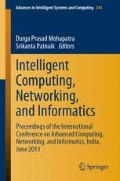Abstract
Conventional iris biometric system, in its localization module, detects iris boundary through integrodifferential intensity change among concentric circles drawn on pupil center. The pupil is detected as the darkest region in human eye. However, this crude approach performs well for constrained iris images captured in near infrared (NIR) spectrum, but may fail for low-quality color eye images captured in visible spectrum (VS). This paper proposes a novel approach that estimates eye gaze and tilt without precise knowledge of pupil location. Rather the proposed technique color-segments the sclera region to find few low-cost nodal points within eye region. The proposed method localizes sclera through a novel color segmentation method applied in YCbCr color space. In the next phase, during content retrieval process of the sclera, typically six nodal points are extracted whose relative positions define the gaze and tilt of the eye of the subject. The Proposed method has been experimented on 100 randomly chosen images from UBIRISv2 unconstrained VS iris database. The experiment yielded 96 % accuracy in proper sclera-localization and extracting the six low-cost nodal points.
Access this chapter
Tax calculation will be finalised at checkout
Purchases are for personal use only
References
Proenca, H., Alexandre, L.A.: Iris segmentation methodology for non-cooperative recognition. IEEE Proc. Vision Image Signal Process. 153(2), 199–205 (2006). doi:10.1049/ip-vis:20050213
Pundlik, S.J., Woodard, D.L., Birchfield, S.T.: Non-ideal iris segmentation using graph cuts. In: Proceedings of IEEE Computer Society Conference on Computer Vision and Pattern Recognition Workshops, 2008, doi:10.1109/CVPRW.2008.4563108
Bakshi, S., Mehrotra, H., Majhi, B.: Real-time iris segmentation based on image morphology. In: Proceedings of 2011 International Conference on Communication, Computing, and Security (ICCCS’11), 2011, ACM, pp. 335–338. doi:10.1145/1947940.1948010
Ma, L., Tan, T., Wang, Y., Zhang, D.: Efficient iris recognition by characterizing key local variations. IEEE Trans. Image Process. 13(6), 739–750 (2004). doi:10.1109/TIP.2004.827237
Chen, Y., Adjouadi, M., Han, C., Wang, J., Barreto, A., Rishe, N., Andrian, J.: A highly accurate and computationally efficient approach for unconstrained iris segmentation. Image Vis. Comput. 28(2), 261–269 (2010). doi:10.1016/j.imavis.2009.04.017
Proença, H., Filipe, S., Santos, R., Oliveira, J., Alexandre, L.A.: The UBIRIS.v2: a database of visible wavelength iris images captured on-the-move and at-a-distance. IEEE Trans. Pattern Anal. Mach. Intell. 32(8), 1529–1535 (2010). doi:10.1109/TPAMI.2009.66
Khosravi, M.H., Safabakhsh, R.: Human eye sclera detection and tracking using a modified time-adaptive self-organizing map. Pattern Recogn. 41(8), 2571–2593 (2008). doi:10.1016/j.patcog.2008.01.012
Acknowledgments
The authors would like to extend their sincere gratitude towards all co-researchers of Department of Computer Science and Engineering, National Institute of Technology Rourkela for their active and hidden participation towards manifestation of this research.
Author information
Authors and Affiliations
Corresponding author
Editor information
Editors and Affiliations
Rights and permissions
Copyright information
© 2014 Springer India
About this paper
Cite this paper
Bakshi, S., Raman, R., Sa, P.K. (2014). A Novel Approach for Eye Gaze and Tilt Estimation. In: Mohapatra, D.P., Patnaik, S. (eds) Intelligent Computing, Networking, and Informatics. Advances in Intelligent Systems and Computing, vol 243. Springer, New Delhi. https://doi.org/10.1007/978-81-322-1665-0_122
Download citation
DOI: https://doi.org/10.1007/978-81-322-1665-0_122
Publisher Name: Springer, New Delhi
Print ISBN: 978-81-322-1664-3
Online ISBN: 978-81-322-1665-0
eBook Packages: EngineeringEngineering (R0)

